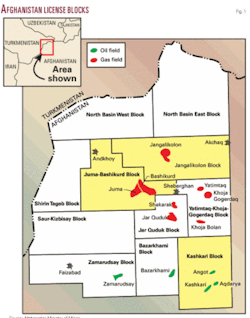Afghanistan’s Ministry of Mines is launching a bid round of three blocks in the lightly explored Afghan-Tajik and Amu Darya basins.
Each of the three blocks contains oil and-or gas discoveries, most of which have never been produced.
Any successful bidder will need the stomach to operate in a landlocked country with sparse infrastructure and undergoing wartime conditions. Oil and gas marketing options are uncertain.
Bids are due June 15, and bidders are to be notified of the outcome by July 1, 2009.
Blocks and fields
Detail is sparse on previous Soviet exploration in the Afghan oil and gas fields.
The Jangalikolon block is the largest at 493,952 acres, Juma-Bashikurd covers 459,853 acres, and Kashkari is 425,753 acres.
The ministry estimated that Jangalikolon has 671 bcf of recoverable gas, Juma-Bashikurd 1.2 tcf, and Kashkari 64.4 million bbl of oil. It also estimated 143.8 million bbl of possible reserves in Kashkari.
Most of Afghanistan’s producing reservoirs are of Cretaceous and Jurassic age, and the bulk of the gas is sour and resides in the Jurassic.
The ministry said the Soviets drilled four wells and started but did not complete another five wells at Jangalikolon, 35 km north of Sheberghan. Well No. 4 went to TD 4,222 m in Upper Jurassic sandstone and tested 35 MMcfd of sour gas at 600 atm bottomhole pressure from a 20-m perforated interval. The gas was 0.035% hydrogen sulfide.
Field size is 7 by 13 km.
The ministry said Juma-Bashikurd field, 25 km northwest of Sheberghan, covers 36 sq km and has seven wells.
The ministry said Angot field, 12 km south of Sari Pol, has produced from four of 10 wells drilled. The field produced an unknown volume for about 6 months in 1988-89, and the produced oil was trucked to Kabul and used to heat water. The reservoir is a Hauterivian limestone at 1,800-1,950 m, and the block contains several smaller oil fields.
Angot field, the only Afghan field to have been on sustained production, was discovered in 1967. Soviets found most of the other fields in the 1970s.
Other information
A road show for the licensing round is in progress, with stops in Dubai, London, Calgary, and Houston, and ending in Singapore on May 15 (OGJ Online, Mar. 19, 2009).
The US Geological Survey, after completing a multiyear study in 2006, estimated Afghanistan’s mean undiscovered resources at 15.7 tcf of gas, 1.6 billion bbl of oil, and 562 million bbl of natural gas liquids (OGJ Online, Mar. 27, 2006).
USGS said much of Afghanistan’s petroleum resource potential and all the known oil and gas reserves are in the north. It said most of the undiscovered oil is in the Afghan-Tajik basin to the east, while most of the undiscovered gas is in the Amu Darya basin that extends into Turkmenistan.
